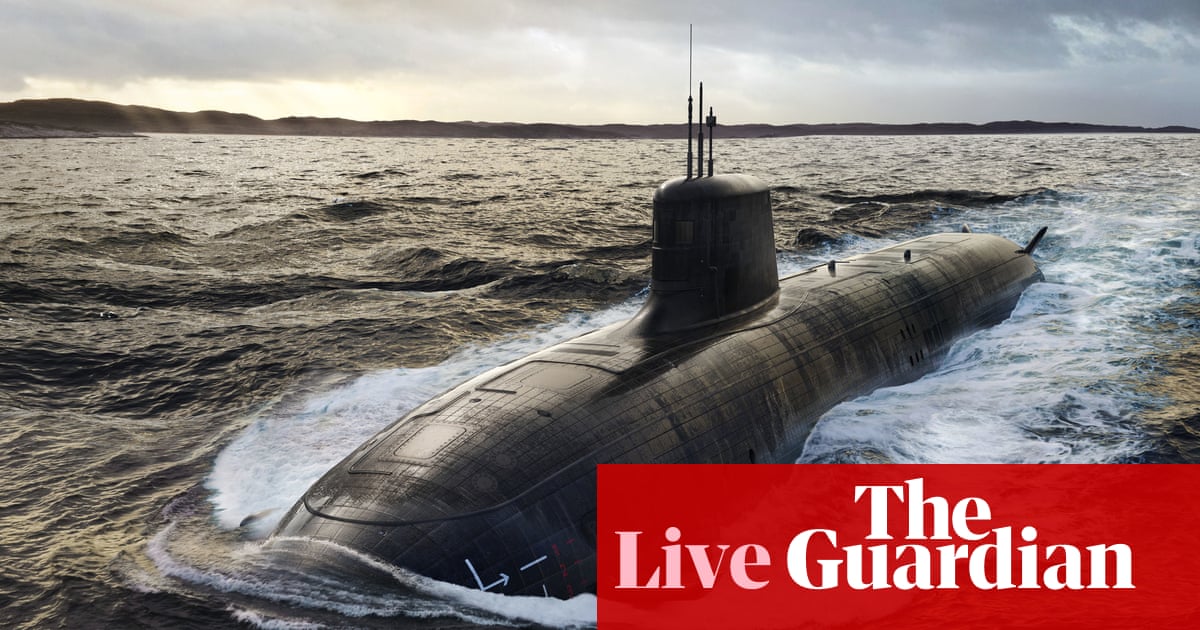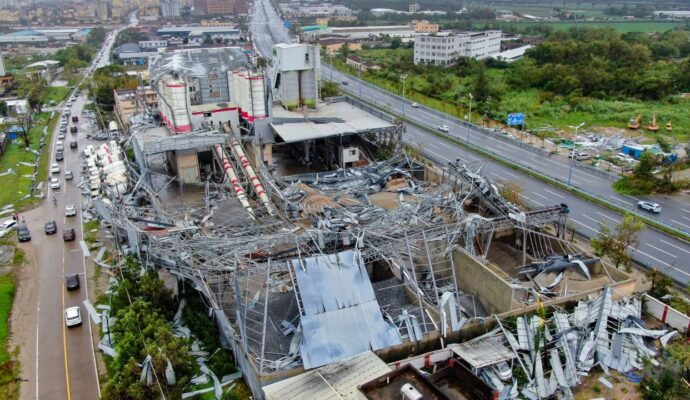
Key points of Aukus submarine deal
Daniel Hurst has also broken the announcement down into key points for you:
Australia’s entire nuclear-powered submarine program – including acquisition, construction and sustainment – is forecast to cost $268bn to $368bn between now and the mid 2050s, most of it beyond the first four-year budget period. This includes $9bn over the initial four-year budget period. The $9bn over the forward estimates is an increase of $3bn compared with the $6bn earmarked for the abandoned French project – and Defence is being asked to offset that $3bn.
Australian shipyard and design construction is expected to begin from 2023. This will include “enabling works this year” in Osborne, South Australian, because the shipyard will be almost three times larger than the yard forecast for the abandoned French submarine program. The government argues up to 4,000 workers will be employed to design and build the infrastructure for the submarine construction yard in Osborne at the peak. In 20 to 30 years, a further 4,000 to 5,500 direct jobs are expected tone created (doubled the workforce for the French program).
Australia and the UK plan to start building the SSN-Aukus submarine in their domestic shipyards “beyond the end of this decade” (starting in the 2020s). But building submarines is a major endeavour, and the government believes the first Australian-built SSN-Aukus would not be finished and delivered to the Royal Australian Navy until the early 2040s.
<gu-island name="KeyEventsCarousel" deferuntil="visible" props="{"keyEvents":[{"id":"640f814e8f080fff7c2bd376","elements":[{"_type":"model.dotcomrendering.pageElements.TextBlockElement","html":"
Daniel Hurst has also broken the announcement down into key points for you:
","elementId":"c92b9814-6281-4b59-8d32-a937d237c4a1"},{"_type":"model.dotcomrendering.pageElements.TextBlockElement","html":"
- \n
Australia’s entire nuclear-powered submarine program – including acquisition, construction and sustainment – is forecast to cost $268bn to $368bn between now and the mid 2050s, most of it beyond the first four-year budget period. This includes $9bn over the initial four-year budget period. The $9bn over the forward estimates is an increase of $3bn compared with the $6bn earmarked for the abandoned French project – and Defence is being asked to offset that $3bn.
Australian shipyard and design construction is expected to begin from 2023. This will include “enabling works this year” in Osborne, South Australian, because the shipyard will be almost three times larger than the yard forecast for the abandoned French submarine program. The government argues up to 4,000 workers will be employed to design and build the infrastructure for the submarine construction yard in Osborne at the peak. In 20 to 30 years, a further 4,000 to 5,500 direct jobs are expected tone created (doubled the workforce for the French program).
Australia and the UK plan to start building the SSN-Aukus submarine in their domestic shipyards “beyond the end of this decade” (starting in the 2020s). But building submarines is a major endeavour, and the government believes the first Australian-built SSN-Aukus would not be finished and delivered to the Royal Australian Navy until the early 2040s.
\n
\n
\n
","elementId":"de800d0c-5786-4462-9665-dcf8b0d7ba96"}],"attributes":{"pinned":true,"keyEvent":true,"summary":false},"blockCreatedOn":1678737742000,"blockCreatedOnDisplay":"16.02 EDT","blockLastUpdated":1678738312000,"blockLastUpdatedDisplay":"16.11 EDT","blockFirstPublished":1678737779000,"blockFirstPublishedDisplay":"16.02 EDT","blockFirstPublishedDisplayNoTimezone":"16.02","title":"Key points of Aukus submarine deal","contributors":[],"primaryDateLine":"Mon 13 Mar 2023 16.28 EDT","secondaryDateLine":"First published on Mon 13 Mar 2023 15.25 EDT"},{"id":"640f81108f088ed9e336857b","elements":[{"_type":"model.dotcomrendering.pageElements.TextBlockElement","html":"
Daniel Hurst is out of the Aukus lockup – here is his first take.
","elementId":"c372e4ae-bdc7-4b42-9cf3-197c806bc0c2"},{"_type":"model.dotcomrendering.pageElements.TextBlockElement","html":"
The main phases of the plan:
","elementId":"50405874-082b-49ed-aeb8-d765da325358"},{"_type":"model.dotcomrendering.pageElements.TextBlockElement","html":"
1. From this year, Australian military and civilian personnel are set to embed with the United States Navy, the United Kingdom Royal Navy “and, subject to any necessary arrangements, within the United States and United Kingdom submarine industrial bases”.
","elementId":"fabca7f5-1337-4fcc-a237-93b59bb15c6d"},{"_type":"model.dotcomrendering.pageElements.TextBlockElement","html":"
This aims to boost training and development of Australian personnel. The US will also increase nuclear-powered submarine port visits to Australia from this year, with Australian sailors joining US crews for training and development, whereas the UK is set to increase visits to Australia from 2026.
","elementId":"112d5523-a084-4513-8cad-8bcc478a7095"},{"_type":"model.dotcomrendering.pageElements.TextBlockElement","html":"
2. From 2027 at the earliest, the UK and the US plan to establish a rotational presence of one UK Astute class submarine and up to four US Virginia class submarines at HMAS Stirling near Perth, Western Australia.
","elementId":"9940ef00-cd8e-41b3-ad8d-1e8c433e718b"},{"_type":"model.dotcomrendering.pageElements.TextBlockElement","html":"
This will be called ‘Submarine Rotational Force-West’ (SRF-West). The Australian government argues this rotational presence “will comply fully with Australia’s longstanding position of no foreign bases on its territory” because these submarines will be rotated through the location and will not be permanently based in Australia. The three countries argue the rotational presence will “put our nations shoulder to shoulder as Australia builds the necessary operational capabilities and skills to steward and operate its own fleet of nuclear-powered submarines”.
","elementId":"fcdc42d9-8c9c-4e5e-9c3e-c7b8c4fbbbee"},{"_type":"model.dotcomrendering.pageElements.TextBlockElement","html":"
3. Beginning in the early 2030s, the US intends to sell Australia three Virginia class submarines, with the potential to sell up to two more if needed (all pending approval from the US Congress).
","elementId":"124457be-1a23-4bdd-ae0b-6f9003101649"},{"_type":"model.dotcomrendering.pageElements.TextBlockElement","html":"
The three governments argue this is “critical to continue growing Australia’s ability to own and operate a fleet of SSNs, and to provide Australia with a sovereign capability at the earliest possible date” while not allowing a capability gap caused by the retirement of Australia’s conventional Collins class submarines from the 2030s.
","elementId":"1a43bdae-c01f-4d6e-813d-4656c6f86d38"},{"_type":"model.dotcomrendering.pageElements.TextBlockElement","html":"
4. The final phase is the delivery of the so-called “SSN-Aukus”, a nuclear-powered attack submarine based on a UK design and featuring advanced US technology. This design will eventually be used by both the UK and Australia. The first Australian-built SSN-Aukus would be delivered to the Royal Australian Navy in the early 2040s.
","elementId":"0800a0e1-de74-4e91-b0d8-aa6c634250b9"}],"attributes":{"pinned":false,"keyEvent":true,"summary":false},"blockCreatedOn":1678737680000,"blockCreatedOnDisplay":"16.01 EDT","blockLastUpdated":1678738345000,"blockLastUpdatedDisplay":"16.12 EDT","blockFirstPublished":1678737713000,"blockFirstPublishedDisplay":"16.01 EDT","blockFirstPublishedDisplayNoTimezone":"16.01","title":"Submarine program to roll out in four phases","contributors":[],"primaryDateLine":"Mon 13 Mar 2023 16.28 EDT","secondaryDateLine":"First published on Mon 13 Mar 2023 15.25 EDT"},{"id":"640eaa4f8f08fe006b95f877","elements":[{"_type":"model.dotcomrendering.pageElements.TextBlockElement","html":"
Welcome to a special edition of our Australia news live blog as we await the details of the Australia, UK and US strategic agreement, Aukus.
","elementId":"9bf51b44-6322-4cc2-aab5-cc444bdff562"},{"_type":"model.dotcomrendering.pageElements.TextBlockElement","html":"
Australia is about to learn the details of the nuclear-powered submarine plan, with the leaders of the three nations coming together in the US to officially make the announcement.
","elementId":"b2af959a-caf7-4c75-8992-74da737fe21e"},{"_type":"model.dotcomrendering.pageElements.TextBlockElement","html":"
The US president, Joe Biden, the British PM, Rishi Sunak, and the Australian prime minister, Anthony Albanese, are in the US for the photo op of photo ops – there has been immense speculation about this agreement – so this should answer *most* questions.
","elementId":"699d4976-5dde-4bc1-8cf0-3191e58413ce"},{"_type":"model.dotcomrendering.pageElements.TextBlockElement","html":"
We will bring you everything you need to know as soon as the embargo lifts. Our defence and foreign affairs correspondent, Daniel Hurst, will bring you the Australian angles as they emerge, while our UK and US colleagues will cover the international response.
","elementId":"1608fa9c-dbed-4d55-8e05-efa125ac7b11"},{"_type":"model.dotcomrendering.pageElements.TextBlockElement","html":"
Ready?
","elementId":"e22c294e-4353-4699-8e9b-6ac011331c0e"},{"_type":"model.dotcomrendering.pageElements.TextBlockElement","html":"
Let’s get into it.
","elementId":"ba78c475-0ee8-4fee-b778-ac787e162d3c"}],"attributes":{"pinned":false,"keyEvent":true,"summary":false},"blockCreatedOn":1678735542000,"blockCreatedOnDisplay":"15.25 EDT","blockLastUpdated":1678735090000,"blockLastUpdatedDisplay":"15.18 EDT","blockFirstPublished":1678735542000,"blockFirstPublishedDisplay":"15.25 EDT","blockFirstPublishedDisplayNoTimezone":"15.25","title":"Good morning","contributors":[],"primaryDateLine":"Mon 13 Mar 2023 16.28 EDT","secondaryDateLine":"First published on Mon 13 Mar 2023 15.25 EDT"}],"filterKeyEvents":false,"format":{"display":0,"theme":0,"design":10},"id":"key-events-carousel-mobile"}”>
Key events
Filters BETA
The White House has released a fact sheet on the agreement. Among the fact breakdown, is how Australia will manage the nuclear waste generated through the submarine program:
Responsible Stewardship of Naval Nuclear Propulsion Technology
All three nations appreciate the enormity of this endeavor and are committed to the principles that have upheld the United Kingdom and United States naval nuclear propulsion programs’ unmatched safety records. For over 60 years, the United Kingdom and United States have operated more than 500 naval nuclear reactors that have collectively travelled more than 150 million miles – the equivalent of over 300 trips to the moon and back – without incident or adverse effect on human health or the quality of the environment. Australia is committed to upholding these same standards to safely steward naval nuclear propulsion technology.
As part of this commitment to nuclear stewardship, Australia has committed to managing all radioactive waste generated through its nuclear-powered submarine program, including spent nuclear fuel, in Australia. The United Kingdom and the United States will assist Australia in developing this capability, leveraging Australia’s decades of safely and securely managing radioactive waste domestically. Australia will manage these materials in accordance with its nuclear non-proliferation and other international obligations and commitments.
Given the UK tories adopting Australia’s ‘stop the boats’ policy, “shared vision” here now means quite a few things.
UK Prime Minister @RishiSunak and I have a shared vision of a secure and stable world.
And tomorrow we'll have more to say on how we're working towards that through AUKUS. pic.twitter.com/TNIat54vpz
— Anthony Albanese (@AlboMP) March 13, 2023
\n","url":"https://twitter.com/AlboMP/status/1635148109243363329?s=20","id":"1635148109243363329","hasMedia":false,"role":"inline","isThirdPartyTracking":false,"source":"Twitter","elementId":"6fc83705-fc9f-4e73-a0b2-f5b924b1a215"}}”>
That statement continued:
This plan is designed to support Australia’s development of the infrastructure, technical capabilities, industry and human capital necessary to produce, maintain, operate, and steward a sovereign fleet of conventionally-armed, nuclear-powered submarines. Australia is fully committed to responsible stewardship of naval nuclear propulsion technology.
When we announced the AUKUS partnership in September 2021, we committed to set the highest nuclear non-proliferation standard. The plan we announce today delivers on this commitment and reflects our longstanding leadership in, and respect for, the global nuclear non-proliferation regime. We continue to consult with the International Atomic Energy Agency to develop a non-proliferation approach that sets the strongest precedent for the acquisition of a nuclear-powered submarine capability. Our plan elevates all three nations’ industrial capacity to produce and sustain interoperable nuclear-powered submarines for decades to come, expands our individual and collective undersea presence in the Indo-Pacific, and contributes to global security and stability. In these outcomes, AUKUS reflects the principle that shared action, taken in partnership, can benefit all. Implementing AUKUS will also require robust, novel information sharing and technology cooperation. Our nations are committed to further trilateral collaboration that will strengthen our joint capabilities, enhance our information and technology sharing, and integrate our industrial bases and supply chains while strengthening the security regimes of each nation. For more than a century, our three nations have stood shoulder to shoulder, along with other allies and partners, to help sustain peace, stability, and prosperity around the world, including in the Indo-Pacific. We believe in a world that protects freedom and respects human rights, the rule of law, the independence of sovereign states, and the rules-based international order. The steps we are announcing today will help us to advance these mutually beneficial objectives in the decades to come.
And now the three-way joint announcement is out – the three leaders have released a statement ahead of their appearance on the USS Missouri within the next hour.
From the statement:
In September 2021, Australia, the United Kingdom and the United States announced AUKUS – a new security partnership that will promote a free and open Indo-Pacific that is secure and stable.
The first major initiative of Aukus was our historic trilateral decision to support Australia acquiring conventionally-armed, nuclear-powered submarines (SSNs). Today, we announce our pathway to achieve this critical capability.
Together we will deliver SSN-Aukus – a trilaterally-developed submarine based on the United Kingdom’s next-generation design that incorporates technology from all three nations, including cutting edge U.S. submarine technologies. Australia and the United Kingdom will operate SSN-Aukus as their submarine of the future. Australia and the United Kingdom will begin work to build SSN-Aukus in their domestic shipyards within this decade.
In order to deliver conventionally-armed, nuclear-powered submarines to Australia at the earliest possible date, we intend to pursue the following phased approach, moving through each phase based on mutual commitments from each nation:
Beginning in 2023, Australian military and civilian personnel will embed with the U.S. Navy, the Royal Navy, and in the United States and United Kingdom submarine industrial bases to accelerate the training of Australian personnel. The United States plans to increase SSN port visits to Australia beginning in 2023, with Australian sailors joining U.S. crews for training and development; the United Kingdom will increase visits to Australia beginning in 2026.
As early as 2027, the United States and United Kingdom plan to begin forward rotations of SSNs to Australia to accelerate the development of the Australian naval personnel, workforce, infrastructure and regulatory system necessary to establish a sovereign SSN capability.
Starting in the early 2030s, pending Congressional approval, the United States intends to sell Australia three Virginia class submarines, with the potential to sell up to two more if needed. This step will systematically grow Australia’s sovereign SSN capability and support capacity.
In the late 2030s, the United Kingdom will deliver its first SSN-AUKUS to the Royal Navy. Australia will deliver the first SSN-AUKUS built in Australia to the Royal Australian Navy in the early 2040s.
And the second half of that announcement:
Our plan elevates Australia’s industrial capacity to produce and sustain advanced SSNs, alongside our AUKUS partners.
Importantly, the SSNs will be an Australian sovereign capability, commanded by the Royal Australian Navy and sustained by Australians in Australian shipyards.
Australia has a proud record of leadership in the international nuclear non-proliferation regime.Australia and our Aukus partners are committed to setting the highest nuclear non-proliferation standard for Australia’s acquisition of SSNs, in continued close cooperation with the International Atomic Energy Agency (IAEA).
These enhanced defence capabilities will make Australia and our partners better able to deter conflict, and help ensure stability and strategic balance are maintained in the Indo-Pacific.
Together with our Aukus partners, the Albanese Government will deliver the Optimal Pathway, providing a superior and sovereign capability, generations of jobs and a record level of investment which will keep Australians safe.
The official announcement from Anthony Albanese and Richard Marles is also out:
Today’s significant Aukus announcement about Australia’s acquisition of nuclear-powered submarines is the single biggest investment in our defence capability in our history and represents a transformational moment for our nation, our Defence Force and our economy.
The agreement will:
Strengthen Australia’s national security and contribute to regional stability in response to unprecedented strategic challenges.
Build a future made in Australia, by Australians, with record investments in defence, skills, jobs and infrastructure.
Deliver a superior capability after a decade of inaction and mismanagement.
Australia, the United Kingdom and the United States have agreed to a phased approach that delivers on the commitments of the Albanese Government and provides significant, long-term strategic benefits for all three countries.
For Australia, the three key elements are:
Increased visits of US submarines commencing in 2023 and UK submarines from 2026, and, beginning in 2027, rotations of UK and US submarines to Australia – this will be key to Australian jobs, infrastructure, technology and our ability to be sovereign ready.
From as early as the 2030s, delivery of three US Virginia class nuclear-powered submarines to Australia – ensuring there is no capability gap.
Australia and the UK will deliver SSN-AUKUS, a new conventionally-armed nuclear-powered submarine, based on a UK design, incorporating cutting edge Australian, UK and US technologies. The UK will deliver its own first SSN-AUKUS in the late 2030s, with the first SSN-AUKUS built in Australia delivered in the early 2040s.
We expect the phased approach will result in $6 billion invested in Australia’s industrial capability and workforce over the next four years, creating around 20,000 direct jobs over the next 30 years.
This whole of nation effort also presents a whole of nation opportunity; for new jobs, new industries, and new expertise in science, technology, and cyber.
Businesses right across the country in every state and territory will have the opportunity to contribute to and benefit from these opportunities over decades.
Over the next four years, this will see $2 billion in expected investment into South Australia, and a further $1 billion in Western Australia.
This commitment from the Australian Government will require funding for the phased approach to amount to around 0.15 per cent of GDP per year, averaged over the life of the program.
The press releases have started rolling in. South Australia will be the home of the Australian nuclear-powered submarine construction – they will be built at Osborne.
This will see an estimated investment in South Australia of $2bn over the Forward Estimates.
The Submarine Construction Yard created for the build of our next-generation nuclear-powered submarines will be almost three times larger than the yard forecast for the Attack class program.
The work in South Australia begins right away – we are already investing in the workforce required and putting in place the infrastructure to support the build.
At its peak, up to 4,000 workers will be employed to design and build the infrastructure for the Submarine Construction Yard in Osborne, South Australia.
A further 4,000 to 5,500 direct shipyard jobs are expected to be created to build nuclear-powered submarines in South Australia when the program reaches its peak – almost double the workforce forecast by the former Government for the Attack class program. This does not include the additional jobs created in the supply chain for the construction or sustainment of submarines.
You can read all about what we know, here:
So there you have it – Australia could spend up to $368bn between now and the mid-2050s for up to five US submarines (at least three, another two if needed) and helping to subsidise the US production (because the US can’t keep up with the demand for the Virginia class submarines).
That will also cover the development of the Adelaide shipyard (at Osborne) to build the future Australian-British submarine.
Still, that is an absolutely eye-watering cost.
Key points of Aukus submarine deal
Daniel Hurst has also broken the announcement down into key points for you:
Australia’s entire nuclear-powered submarine program – including acquisition, construction and sustainment – is forecast to cost $268bn to $368bn between now and the mid 2050s, most of it beyond the first four-year budget period. This includes $9bn over the initial four-year budget period. The $9bn over the forward estimates is an increase of $3bn compared with the $6bn earmarked for the abandoned French project – and Defence is being asked to offset that $3bn.
Australian shipyard and design construction is expected to begin from 2023. This will include “enabling works this year” in Osborne, South Australian, because the shipyard will be almost three times larger than the yard forecast for the abandoned French submarine program. The government argues up to 4,000 workers will be employed to design and build the infrastructure for the submarine construction yard in Osborne at the peak. In 20 to 30 years, a further 4,000 to 5,500 direct jobs are expected tone created (doubled the workforce for the French program).
Australia and the UK plan to start building the SSN-Aukus submarine in their domestic shipyards “beyond the end of this decade” (starting in the 2020s). But building submarines is a major endeavour, and the government believes the first Australian-built SSN-Aukus would not be finished and delivered to the Royal Australian Navy until the early 2040s.


